冀教版八年级下英语教案设计(新)
- 格式:doc
- 大小:39.50 KB
- 文档页数:7
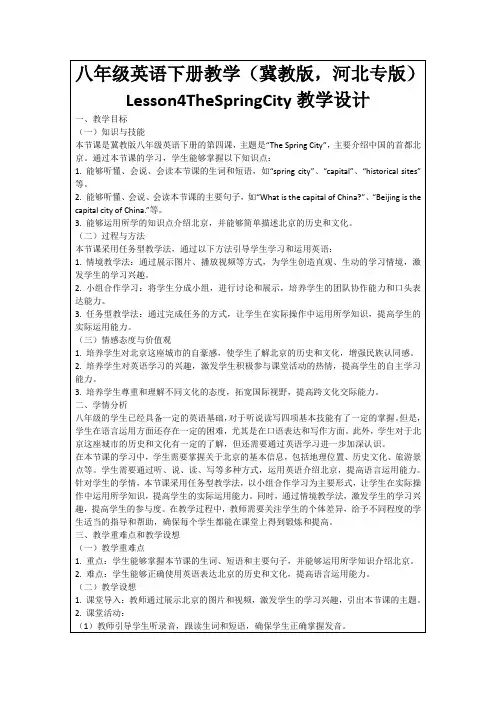
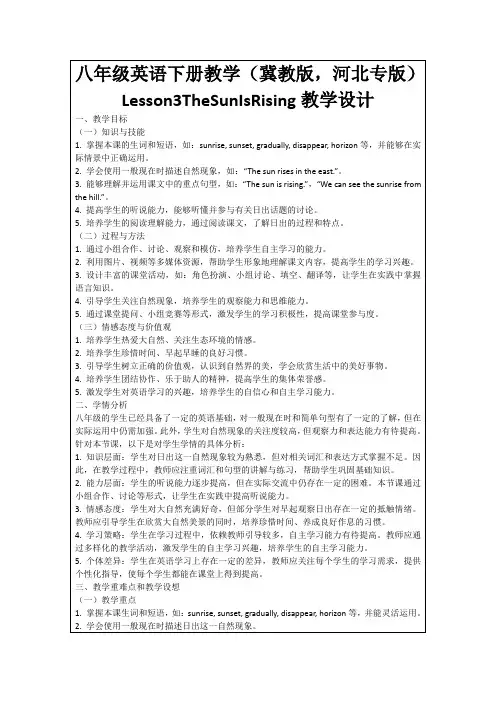

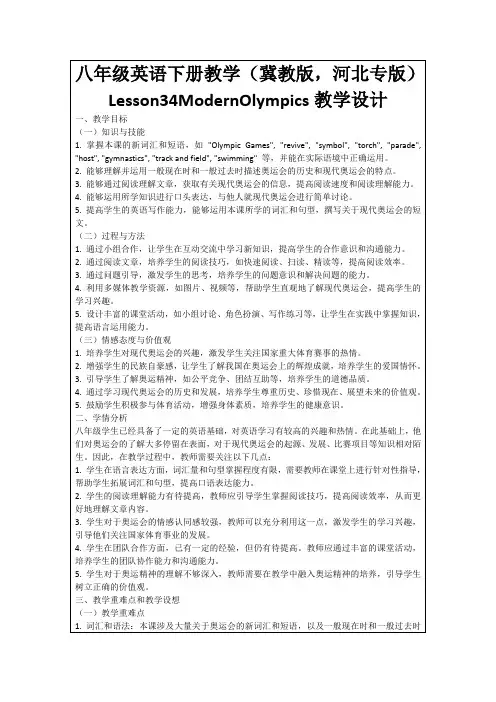
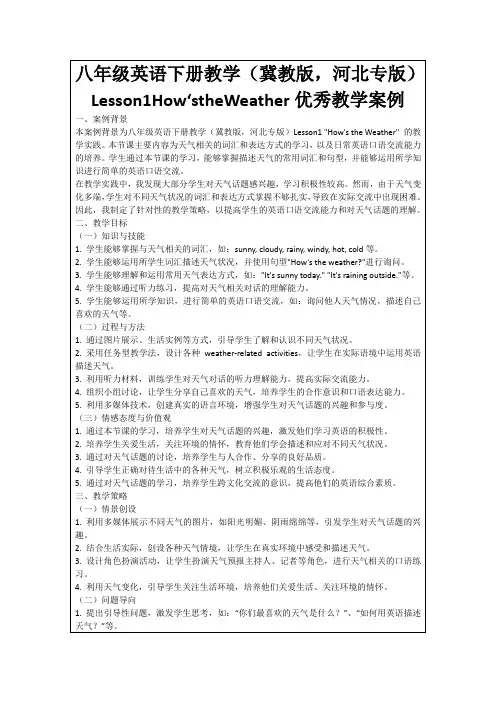

新冀教版八年级英语下册Unit1 Lesson4教学设计一、Instructional Analysis1. Analysis of Teaching ContentThis unit focus on weather and activities related to the spring season. Students will learn to report on the weather, and discuss different topics and activities that relate to spring. Lesson 4 teaches students how to describe the spring in their hometown.2. Analysis of the StudentsThe students of Grade Eight have mastered certain vocabularies. Through the last three lessons, they can talk about spring weather, activities, temperature, etc. But they don’t know how to describe their hometown in a proper way. They are interested in different kinds of activities in class like interviews and competitions.二、Teaching Aims1. Knowledge Objects1). To learn how to describe the spring in their hometown in a proper way.2).To learn new vocabularies: nearly, plenty3). To learn new phrases: long for/feel like /all year round/plenty of /because of by reading and listening to the text.2. Ability ObjectsTo develop the students’abilities of reading3. Moral Objects1).To cultivate the students’interests of learning English.2).To arouse students to love their hometown4. Learning StrategyIndividual learning、group-work and task-based learning三、Teaching Important and Difficult Points1. Teaching Important Point:To learn to how to describe the spring in their hometown in a proper way.2. Teaching Difficult Point:To ask students to describe the spring in their hometown using what they’ve learned in this lesson.四、Teaching Aids:Multi-media, tape recorder;五、Teaching ProceduresUnit 1 The spring is coming!Lesson 4 The Spring City Groups ScoreABCDLet’s work together to make Tangshan a bet ter place.七、Teaching reflection。
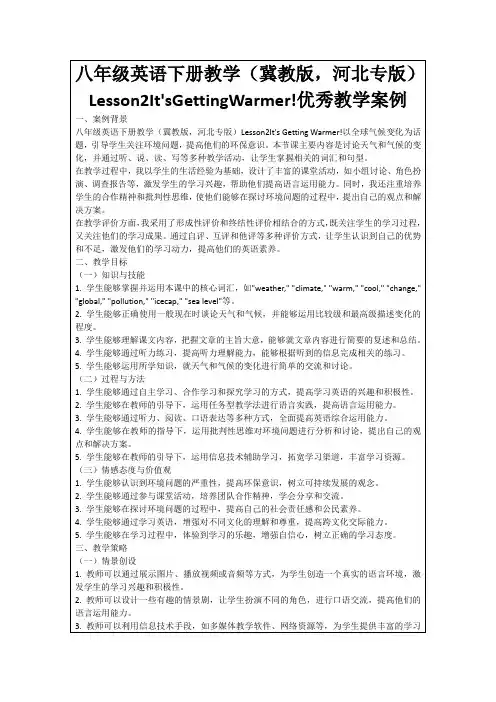

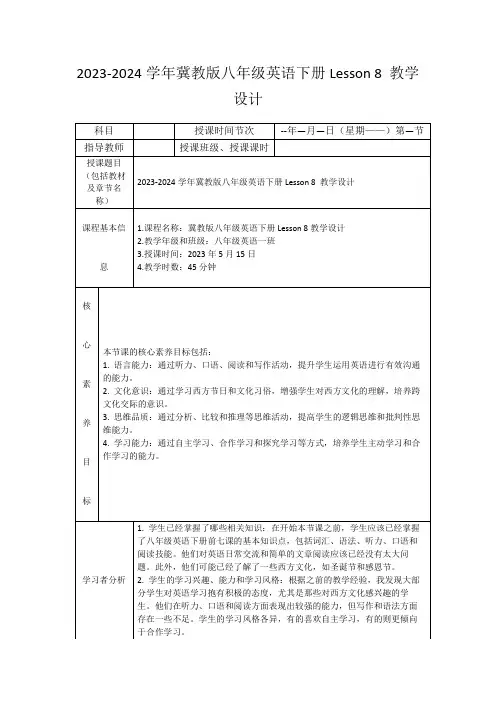
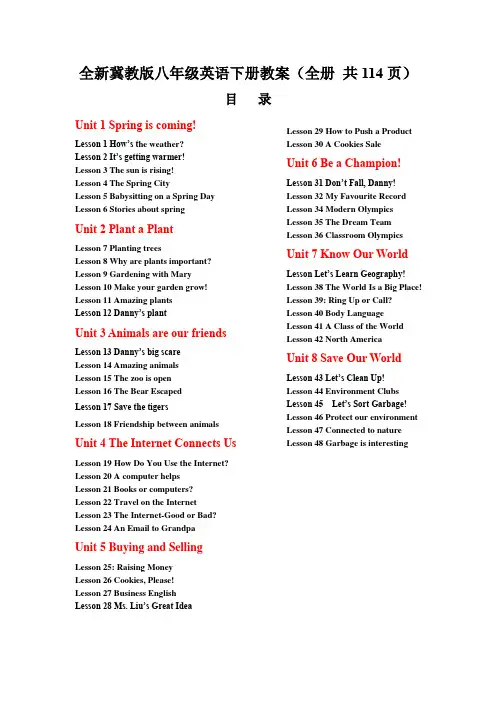
全新冀教版八年级英语下册教案(全册共114页)目录Unit 1 Spring is coming! Array Lesson 1 How’s t he weather?Lesson 2 It’s getting warmer!Lesson 3 The sun is rising!Lesson 4 The Spring CityLesson 5 Babysitting on a Spring DayLesson 6 Stories about springUnit 2 Plant a PlantLesson 7 Planting treesLesson 8 Why are plants important?Lesson 9 Gardening with MaryLesson 10 Make your garden grow!Lesson 11 Amazing plantsLesson 12 Danny’s plantUnit 3 Animals are our friendsLesson 13 Danny’s big scareLesson 14 Amazing animalsLesson 15 The zoo is openLesson 16 The Bear EscapedLesson 17 Save the tigersLesson 18 Friendship between animalsUnit 4 The Internet Connects UsLesson 19 How Do You Use the Internet?Lesson 20 A computer helpsLesson 21 Books or computers?Lesson 22 Travel on the InternetLesson 23 The Internet-Good or Bad?Lesson 24 An Email to GrandpaUnit 5 Buying and SellingLesson 25: Raising MoneyLesson 26 Cookies, Please!Lesson 27 Business EnglishLesson 28 Ms. Liu’s Great IdeaUnit 1 Spring is coming!Lesson 1 How’s the weather?◆教材分析本节课是冀教版初中英语八年级下册第一单元lesson1,功能话题是谈论天气;文本结构是对话;语法重点是初步认识合成词,并能够运用将来时态预测天气,以及正确使用will写简短的天气预报。
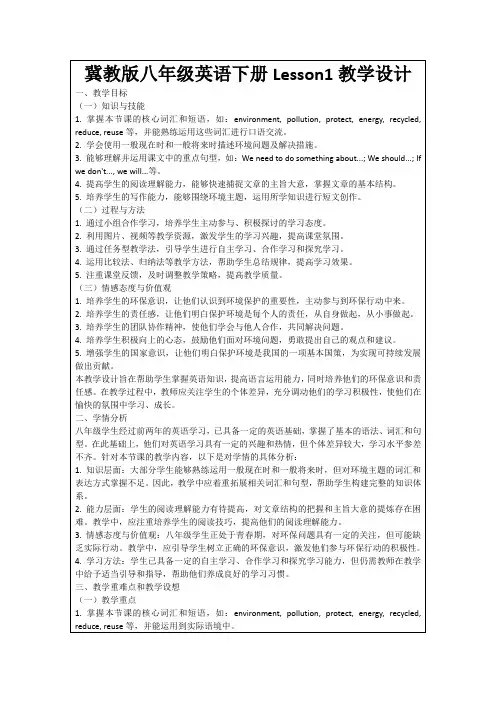
新教材(冀教版)八年级英语(下册)教学设计Teaching design of new textbook (Hebei Educ ation Press) Grade 8 English (Volume 2)新教材(冀教版)八年级英语(下册)教学设计前言:小泰温馨提醒,英语作为在许多国际组织或者会议上都是必需语言,几乎所有学校选择英语作为其主要或唯一的外语必修课。
英语教学涉及多种专业理论知识,包括语言学、第二语言习得、词汇学、句法学、文体学、语料库理论、认知心理学等内容。
本教案根据英语课程标准的要求和针对教学对象是初中生群体的特点,将教学诸要素有序安排,确定合适的教学方案的设想和计划、并以启迪发展学生智力为根本目的。
便于学习和使用,本文下载后内容可随意修改调整及打印。
Lesson 25 Let’s Do An Experiment!LESSON PRERATATIONWords and phrases:science, experiment, fill, prove, theory, jar, upside, observe, right side up, upside down.LESSON STRUCTURECLASS OPENING: Greedeach other.KEY STEPS:STEP 1: Ask the class to discuss the questions inthe “Think AboutIt”.STEP 2: Let the students listen to the tape carefully with thefollowing question:” Why does Danny say they should do this experiment outside?” ;“ What’s Brain’s theory? ”; “ What will Brain do?”; “Does Danny have the same theory as Brain’s?”STEP3: listen to the tape again. The student’s better read the dialogue at the same time. After reading and listening, let the students fill in the chart by themselves.What do we need when we do the experiment?Water, a jar, A piece of cardboardHow do we do it?(steps)1.fill…in…;2.cover…with…;3.turn…upside down.What are Brain’s and Jenny’s theories?1.The floor gets wet.2.The floor won’t get wet.ReasondiscussStep 4: after filling it, ask the students to describe the experiment. Then, write it in the exercise-book.Step 5.read the dialogue and act it out by the students.Step 6.homework. Be ready to give us a morning report of tomorrow.Language Notes:Explain some sentences and phrases.1.I fill a jar with water.fill…with…On hearing the news. Her eyes filled with tears.2.I turn the jar upside down.upside downThat picture is upside down.3.I think the floor will get wet.The days gets longer in spring.4.I’m sure that the floor won’t get wet.Tom ia sure that he will win the game.5.We can prove who’s right.My theory will prove (to be) right some day.6.We’ll d o the experiment and observe what will happen.I observed her dance.CLASS CLOSING:Say good-bye to the students.-------- Designed By JinTai College ---------。
冀教版八年级下英语教案设计(新)第一篇:冀教版八年级下英语教案设计(新)冀教版八年级英语下册Lesson4教学设计与反思底庙中学张娟娟一、教材依据: Unit1: Spring is coming! Lesson 4: The Spring City二、教材分析:本单元围绕春天展开中心话题,描述了春天的天气和户外活动,加强了同学们对异国文化的了解和对祖国文化的热爱提高了学生学习英语的兴趣。
三、学情分析:现在初二的学生对于英语学习应该具有一定的基础和方法,但我们所处在山区农村中学,从初一才开始接触英语,所以对于英语的学习还没有掌握好的方法,学生在学习中还存在许多问题。
对于所学句子还不能在平时灵活运用,所以课堂中老师应尽可能多的运用多种教学方法来引导学生学习。
四、教学目标:1、知识与技能目标掌握本课的单词,了解春城——昆明的美景,并能在听听录音时,有目的的获取所需关键信息。
2、过程与方法目标通过听录音,自读及小组合作的方法学习课文,让学生热爱春天,热爱大自然!3、情感态度与价值观能通过谈论春天的天气,温度,空气和植物,让学生了解春天,热爱春天,了解异国文化和祖国文化的差异,拥抱大自然!五、教学重难点1、单词2、短语及语法六、教法与学法小组讨论、合作探究、教师指导七、课型新授八、教学过程 Step 1.Lead-in A warming-upA saying Step 2.pictures show and new words, then, listening Show some pictures about spring and learn the new words by playing a game, the do the listening aboutthe text and answer one simple question. What is the spring city? It’s Kunming. Step 3.Reading Ask several students to read the text and pay attention to the new words, the students read it again, and discuss together about the four q uestions in “Let’s Do It.part1” Step 4. Listening Do the listening in “Let’s Do It!”part2, listen to it twice, and then invite some students to answer them.Step 5.Discussing Divide the class into small groups; write the following words on the blackboard: Air/weather/ plants/ and outdoor activities. Stepnguage points 1. feel like /sound like / smell like / taste like feel like doing sth. 2. because and because of Because +句子Because of + n./pron./doing3. hundreds of /基数词+单位名词(hundred/thousand/million/billion) 4. think of =consider 5. all over the world =around the world 6. all year round 7. plenty of=a lot of =lots of 8. long for= look forward to Step 6.Homework1、Write a short passage about spring in your hometown2、Preview Lesson 5 Step 7.Summary:Review the text is very important. The students know what they will take to the class, what is useful to the study. Let them to talk about The Spring City. --- Its air, weather, plants and the outdoor activities in spring.九、板书设计:Lesson 4: The Spring City Air weather plants and the outdoor activities十、教学反思:本节课在前几节课学习的基础上进一步来学习春天,通过运用多媒体向学生展示了春天的景色。
冀教版英语教学设计八下一、教学目标1. 听说:通过本单元的学习,学生能够听懂并正确运用与购物相关的日常用语。
2. 读写:学生能够正确理解并运用本单元所学的单词和短语,能够正确书写并运用重要句型。
3. 综合能力发展:培养学生的听说能力,增强他们的语言交际能力和跨文化交际能力。
二、教学重点与难点1. 教学重点:学生能够听懂并正确运用与购物相关的日常用语。
2. 教学难点:学生能够正确理解并运用本单元所学的重要句型。
三、教学准备课件、录音机、图片、单词卡片、小黑板等。
四、教学过程Step 1:导入新课(5分钟)1. 教师与学生打招呼,询问学生的近期购物经历,引入本单元话题。
2. 教师出示图片,让学生尽量用英语描述图片中的商品。
Step 2:新课学习(30分钟)1. 听力训练(1)播放录音,让学生听一段对话,理解并回答相关问题。
(2)教师与学生一起复习并运用对话中的日常用语,如“How much is this?”等。
2. 词汇学习(1)教师出示单词卡片,引导学生认读单词,并进行拼写和发音练习。
(2)师生一起讨论单词的义项,并进行词语搭配练习。
3. 句型学习(1)教师出示重要句型,通过示范和让学生模仿的方式学习句型的用法。
(2)学生们进行角色扮演,使用所学句型进行购物对话练习。
Step 3:听力训练(15分钟)1. 教师播放录音,学生们仔细倾听并完成听力练习。
2. 学生们模仿录音中的对话进行朗读,加强语音语调训练。
Step 4:拓展活动(20分钟)1. 听力巩固练习教师设计一系列购物场景,播放录音让学生们根据录音内容选择正确的答案。
2. 角色扮演学生们分成小组进行角色扮演,模拟真实的购物情景对话,并进行表演。
Step 5:作业布置(5分钟)1. 词汇练习:学生们完成课后练习册中与本单元词汇相关的练习。
2. 写作训练:学生们写一篇关于自己购物经历的短文。
五、教学反思在这堂课中,我充分利用了多媒体和互动的教学手段,使学生更好地参与到课堂中,提高了他们的学习兴趣。
全新冀教版八年级英语下册教案(全册共155页)目录Unit 1 Spring is coming!Lesson 1 How’s the weather?Lesson 2 It’s getting warmer!Lesson 3 The sun is rising!Lesson 4 The Spring CityLesson 5 Babysitting on a Spring Day Lesson 6 Stories about springUnit 2 Plant a PlantLesson 7 Planting treesLesson 8 Why are plants important? Lesson 9 Gardening with MaryLesson 10 Make your garden grow! Lesson 11 Amazing plantsLesson 12 Danny’s plantUnit 3 Animals are our friends Lesson 13 Danny’s big scareLesson 14 Amazing animalsLesson 15 The zoo is openLesson 16 The Bear EscapedLesson 17 Save the tigersLesson 18 Friendship between animals Unit 4 The Internet Connects Us Lesson 19 How Do You Use the Internet? Lesson 20 A computer helpsLesson 21 Books or computers?Lesson 22 Travel on the InternetLesson 23 The Internet-Good or Bad? Lesson 24 An Email to Grandpa Unit 5 Buying and Selling Lesson 25: Raising MoneyLesson 26 Cookies, Please!Lesson 27 Business English Lesson 28 Ms. Liu’s Great Idea Lesson 29 How to Push a Product Lesson 30 A Cookies SaleUnit 6 Be a Champion! Lesson 31 Don’t Fall, Danny! Lesson 32 My Favourite Record Lesson 33 2800 Years of Sports Lesson 34 Modern Olympics Lesson 35 The Dream Team Lesson 36 Classroom Olympics Unit 7 Know Our World Lesson Let’s Learn Geography! Lesson 38 The World Is a Big Place! Lesson 39: Ring Up or Call? Lesson 40 Body LanguageLesson 41 A Class of the World Lesson 42 North AmericaUnit 8 Save Our World Lesson 43 Let’s Clean Up!Lesson 44 Environment Clubs Lesson 45 Let’s Sort Garbage! Lesson 46 Protect our environment Lesson 47 Connected to nature Lesson 48 Garbage is interesting.Unit 1 Spring is coming!Lesson 1 How’s the weather?◆教材分析本节课是冀教版初中英语八年级下册第一单元lesson1,功能话题是谈论天气;文本结构是对话;语法重点是初步认识合成词,并能够运用将来时态预测天气,以及正确使用will写简短的天气预报。
冀教版八年级下英语教案设计常丰中学:海敏Unit 2 Lesson 13 why are plants important?【课题】:why are plants important?【教材与学生分析】本教材充分吸收了国际上新的外语教学理念和实践经验,以人物的活动为主线,围绕最基本最常用的词汇、句型逐步展开教学,有丰富多彩的练习形式和文化背景,把探究学习引入教学中使学生能主动的融入创造性有意义的整体性学习中.现在初二的学生对于英语学习应该具有一定的基础和方法,但我们所处在山区农村中学,从初一才开始接触英语,所以对于英语的学习还没有掌握好的方法,学生在学习中还存在许多问题。
就这一班学生来说已有一定的英语的基础,但还不能在英语学习中运用灵活运用,所以课堂中老师应尽可能多的运用多种教学方法来引导学生学习。
【教学目标】:语言知识:掌握本课的单词及植物植物在我们生活中的重要作用。
语言技能:在听录音时有目的的获取所需关键信息。
语言运用:能通过学习本课的对话简单的复述课文,加强对本课的阅读、理解。
情感态度:能通过谈论植物的重要性,让学生掌握植物在生活中的重要作用,并且让学生树立爱护植物的思想。
Teaching Aims:A: Learn the importance of the trees.B: Learn to how to express the usage of the trees. Learning aims:1. Remember the new words: air, energy, die, heat, nothing, bamboo, kilogram, shade, carry away, make…into.2. The important sentences:①Trees help clean the air.②Donuts don’t grow on the trees!③All plants take energy from the sun and make it into food.④Without food, they would have nothing to eat and they would die.Language Focus:1. Trees can help clean the air.help…(to) do sth. / help …with sth. 帮助…做…2. Donuts don’t grow on trees!on the tree (on trees) 与in the tree (in trees):on the tree (on trees): “在树上”,指树本身所长的东西,如树叶,花等。
(用on表示在树的枝叶中。
)in the tree (in trees): “在树上”,表示不属于树本身生长的,如鸟,人等。
(用in表示在枝叶上。
)3. Then the wind and water don’t carry the soil away. 风和水就不能把土壤带走。
carry away: (1)运走,拿走(2)使着迷;激动carry back:(1)运回,拿回(2)使回想起carry on: (1)继续进行(2)吵吵闹闹carry through: (1)进行(到底)(2)使度过(困难,危险等)。
carry off: (1)轻而易举地完成(2)夺去(某人)生命,拐去。
【教学重点及难点】:1、掌握植物在生活中的重要作用。
2、学习怎样用英语表达植物的作用。
Learning important and difficult points:1. 区分短语in trees 与on trees。
2. Master “Why are plants important?”【教学方法】:任务教学法,学生中心教学法,多媒体教学。
Learning method: Listen, say, read and write.Teaching times :one classPreparation of teaching aids: tape recorders, tapes,multi-media.Teacheing times:one classTime: 45 minutesTeaching Process:Step 1: GreettingStep2: TalkingTalk about: Why do we need trees? What kind of things can plants do?Step 3: Revision.Ask some questions:1.How many main parts do plants have? What are they?2. What do plants need to grow? Why do plants need them?3. Do you think plants are important?Step4:. LearningLearn new words.Step 5:Think about it .Step6: Listion to the tape and answer quitions:1. What are Danny, Jenny and Brian talking about?They are talking about trees and the reason why we need them .2. Donuts don’t grow on trees, do they? No, they don’t.3.Why do we need trees ?Ask some students answer and the teacher correctStep7: ReadingRead the dialogue first. Then find out the useful expressions.1. talk about2. clean the air3. on trees/in trees4. carry…awayStep 8 : look at the picture .know the fascinating facts.Step9: studing language points1、Let’s = Let us2、help sb. (to) do sth.和help sb. with sth.3、pleasant 与pleased的区别Among与between的区别4、on the tree (on trees)in the tree (in trees)5、also, too与either6、carry away把搬(移)走carry back运回,拿回carry off轻而易举地完成carry out 执行carry forward发扬,推进7、make into把制成用于主动语态,be make into用……制成,用于被动语态Step10:PracticePractice the dialogue in pairs.Step 11: projectStep12: Do exercisesStep 13: HomeworkWrite a diary about why we need trees.Preview Lesson 14Summary:Review the text is very important. The students know what they will take to the class, what is useful to the study. Let them to talk about Why Are Plants Important? Why do we need trees? What kind of things can plants do?板书设计:1、help…(to) do sth. / help …with sth. 帮助…做…2、on the tree (on trees) 与in the tree (in trees):on the tree (on trees):in the tree (in trees):3、carry away: (1)运走,拿走(2)使着迷;激动carry back:(1)运回,拿回(2)使回想起carry on: (1)继续进行(2)吵吵闹闹carry through:(1)进行(到底)(2)使度过(困难,危险等)。
carry off:(1)轻而易举地完成(2)夺去生命,拐去.4、Let’s = Let uslet sb. do sth.“肯定回答一般用“OK”“All right.”“Yes, let’s…”。
否定回答用”Sorry, I …”。
5、辨析:also, too与eitheralso较正式,位置靠近动词,不置于句末。
too用于口语,常置于句末,边用逗号,也可用于句中,前后均用逗号。
either一般用于否定句中5、make into把制成用于主动语态,be make into用……制成,用于被动语态。
教学反思:本节课在前几节课学习的基础上进一步来学习植物的重要性,通过运用多媒体向学生展示了植物的作用。
并结合问题“Why do we need trees?”、“What kind of things can plants do?”and “Why Are Plants Important?”来理解课文,在学习单词、短语、句子的同时要求学生理解运用,取得了较好的效果。
本课的学习让学生充分的认识了植物对人类生活的重要作用,培养了学生爱护植物的情感。
达到理想的教学效果。